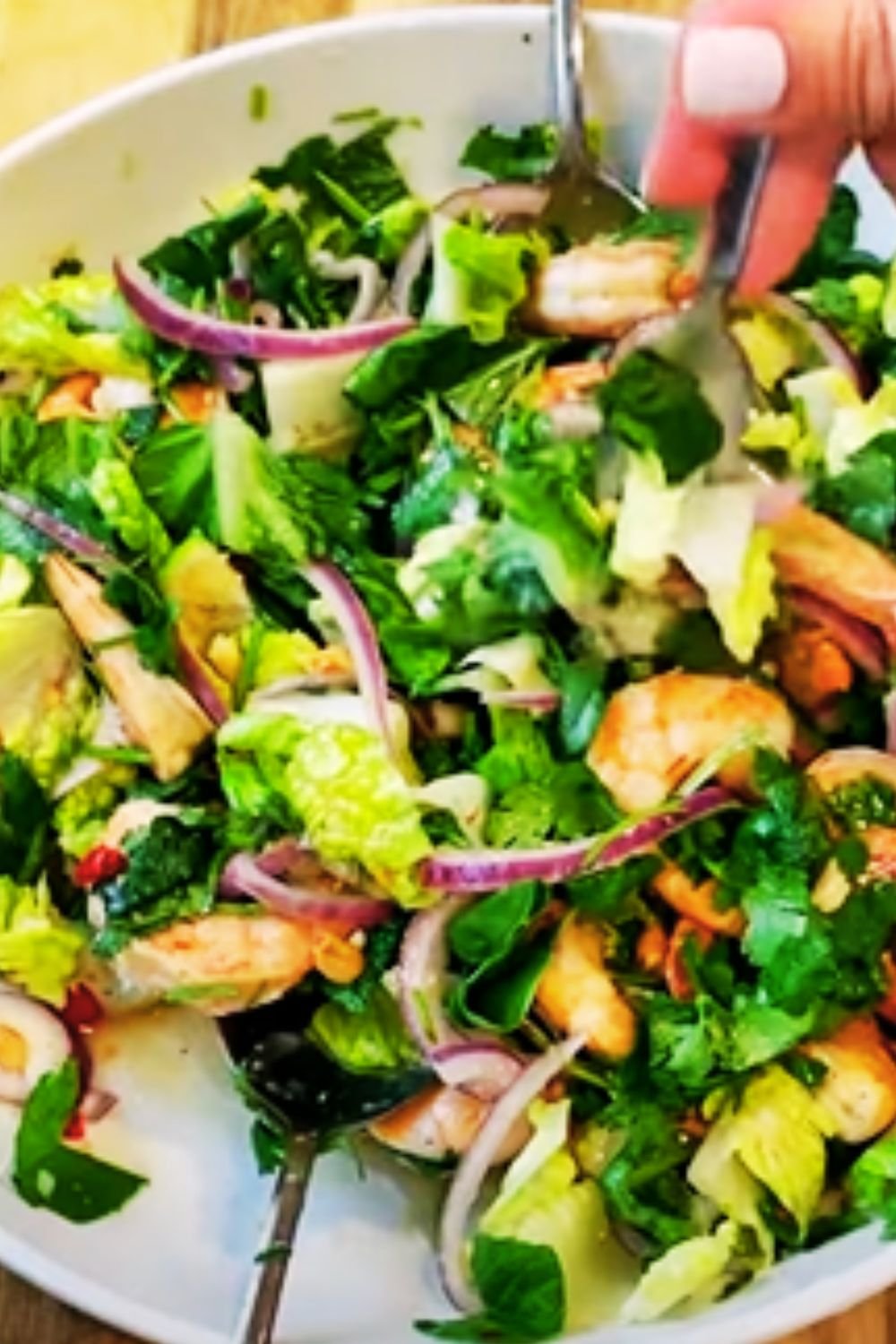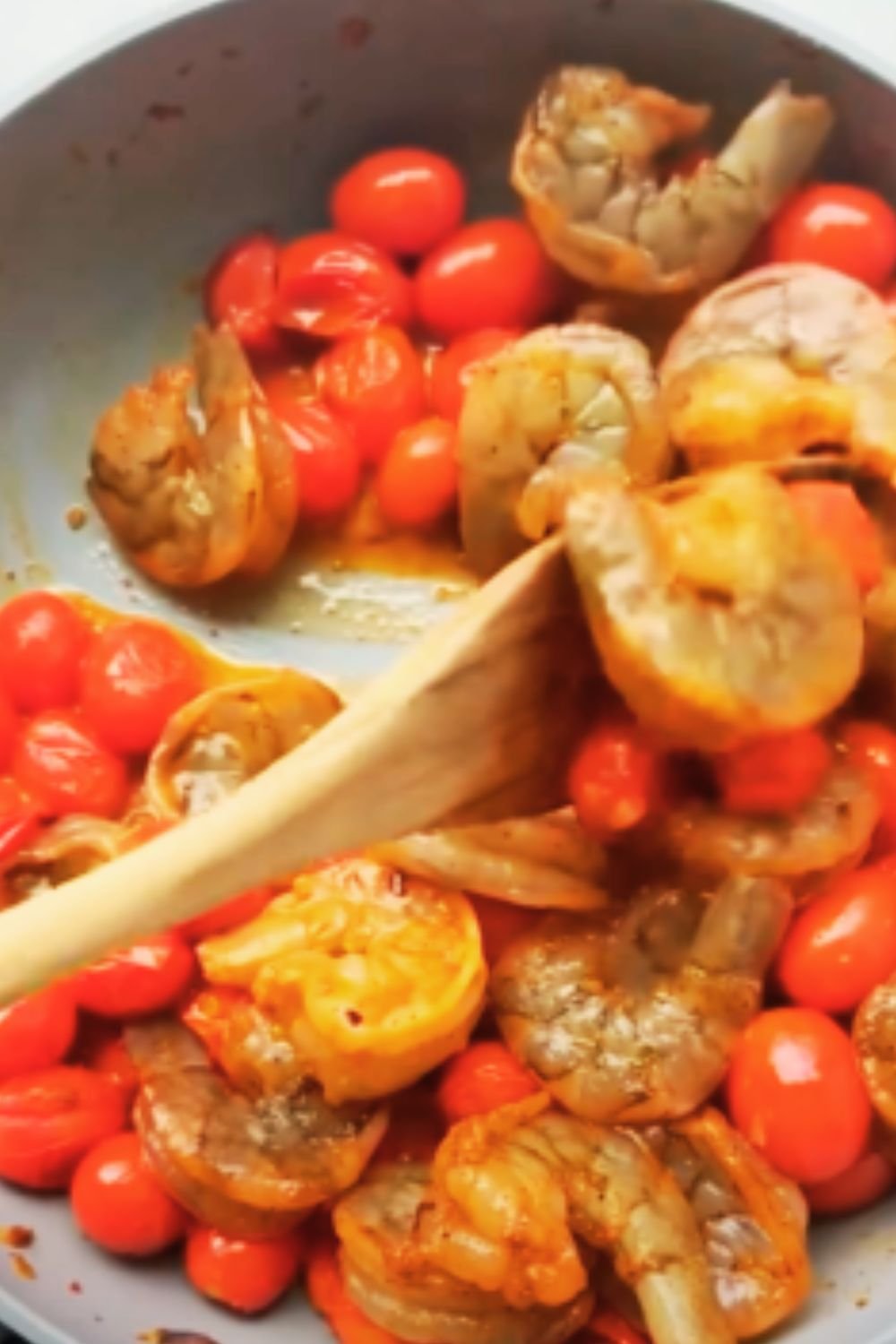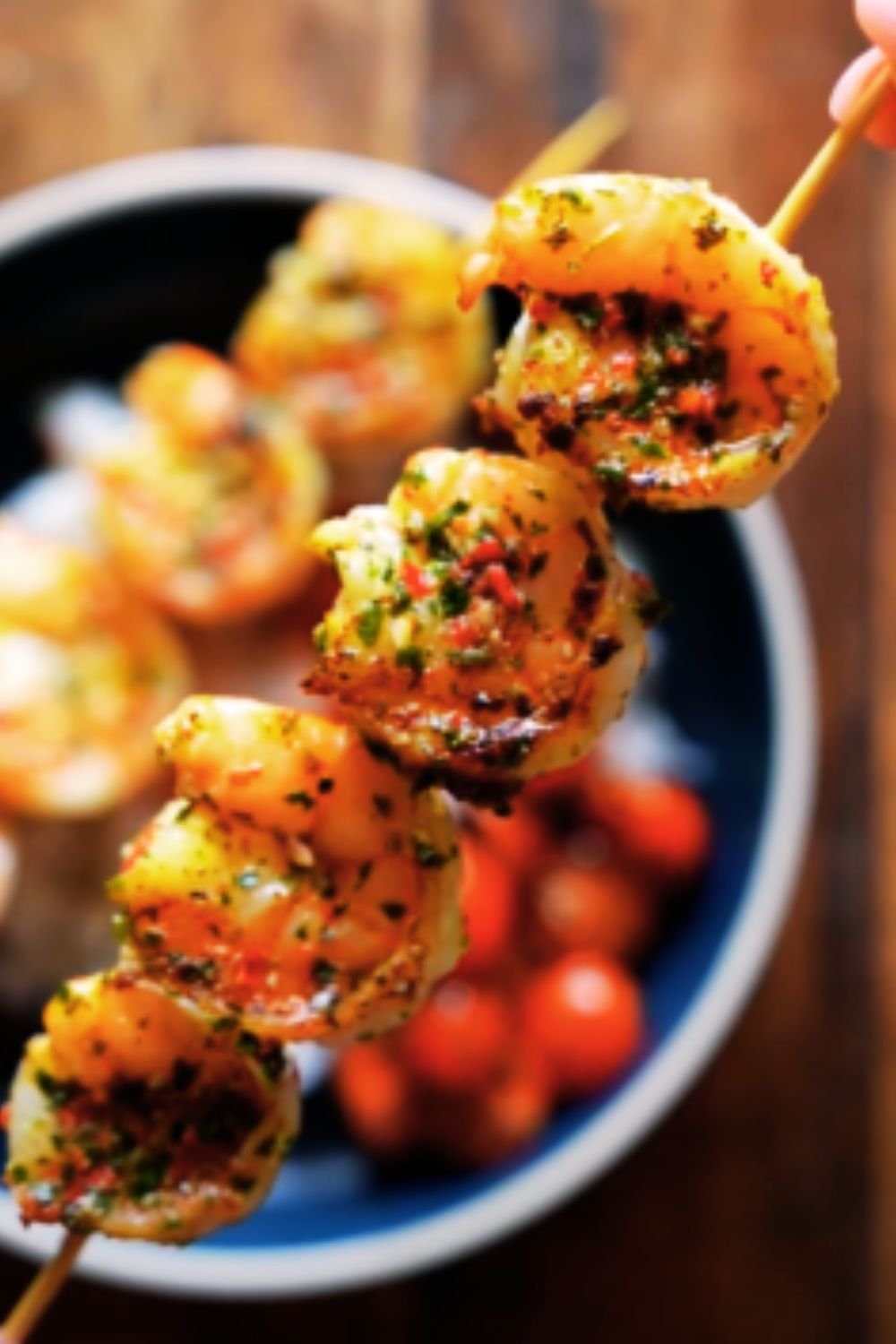Have you ever tasted something so vibrant and flavorful that it transported you instantly to another country? That’s exactly what happened the first time I tried authentic Pla Goong in a small roadside eatery in Bangkok. The explosion of spicy, tangy, and aromatic flavors left me speechless, and I knew I had to master this dish when I returned home.
Today, I’m thrilled to share my perfected recipe for Spicy Thai Shrimp Salad, known in Thailand as “Pla Goong.” This isn’t just any salad—it’s a masterclass in balancing Thailand’s four fundamental flavors: spicy, sweet, sour, and salty. And the best part? You can recreate this restaurant-quality dish right in your own kitchen.
What is Pla Goong?
Pla Goong (พล่ากุ้ง) is a traditional Thai salad featuring succulent shrimp tossed in a spicy lime dressing and mixed with fresh herbs and aromatics. The name breaks down as “Pla” meaning a spicy salad preparation technique and “Goong” meaning shrimp. Unlike many Western salads that use leafy greens as a base, Pla Goong highlights the shrimp as the star, complemented by herbs rather than buried beneath them.
Originally from Thailand’s northeastern Isaan region, this dish has become popular throughout the country and internationally for its perfect harmony of flavors and textures. It’s light yet satisfying, making it ideal for hot summer days or as a starter for a larger Thai feast.
Culinary Heritage of Pla Goong
The roots of Pla Goong trace back to the Isaan region of Thailand, where the cuisine is characterized by bold flavors, abundant fresh herbs, and fiery chilies. Traditionally, this dish would be made with freshwater shrimp caught from local rivers and ponds, then briefly cooked to maintain their tender texture.
What makes Pla Goong special is the preparation technique. Unlike other Thai salads where ingredients are pounded in a mortar and pestle, Pla Goong ingredients are mixed gently to preserve the integrity of the shrimp and fresh herbs. This technique showcases the Thai culinary philosophy of treating ingredients with respect while creating bold flavor combinations.
Essential Ingredients for Authentic Pla Goong
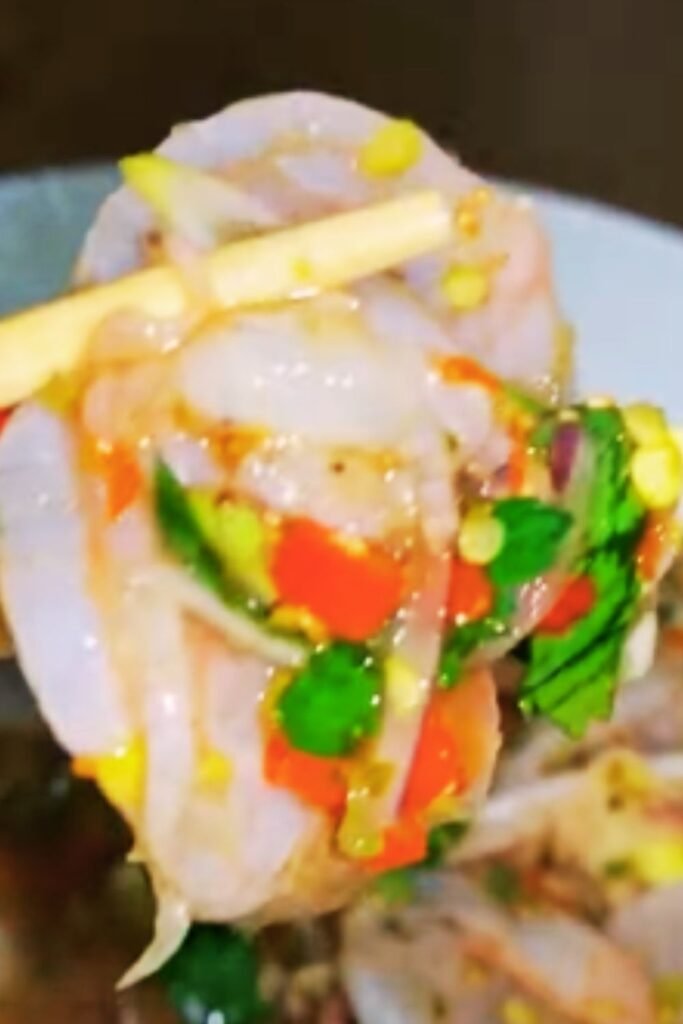
To create an authentic Pla Goong experience, you’ll need to gather some specific ingredients. While some may require a trip to an Asian market, the effort is absolutely worth it:
Core Ingredients:
- Shrimp: 1 pound (450g) medium to large shrimp, peeled and deveined
- Lemongrass: 2 stalks, thinly sliced (use only the tender white parts)
- Shallots: 4 medium, thinly sliced
- Mint leaves: 1 cup, loosely packed
- Cilantro: 1/2 cup, roughly chopped
- Kaffir lime leaves: 4-5 leaves, finely sliced (optional but highly recommended)
- Thai bird’s eye chilies: 5-8, depending on your heat preference
- Green onions: 4, sliced diagonally
For the Dressing:
- Lime juice: 1/4 cup fresh (approximately 3-4 limes)
- Fish sauce: 3 tablespoons
- Palm sugar: 1 tablespoon (can substitute brown sugar)
- Garlic: 3 cloves, minced
- Chili powder: 1 teaspoon (Thai style if available)
Garnish:
- Roasted rice powder (Khao Khua): 1 tablespoon
- Extra mint leaves and cilantro
- Lime wedges
- Sliced cucumber
Let’s break down some of the less familiar ingredients:
Kaffir lime leaves: These glossy, dark green leaves have a unique citrusy aroma that’s essential in many Thai dishes. If unavailable, substitute with lime zest.
Thai bird’s eye chilies: Small but mighty chilies that pack serious heat. Adjust the quantity based on your spice tolerance.
Roasted rice powder: This ingredient adds a subtle nutty flavor and slight texture to the salad. You can make it by dry-roasting uncooked glutinous rice in a pan until golden brown, then grinding to a coarse powder.
Equipment You’ll Need
The beauty of Pla Goong is its simplicity. You’ll need minimal equipment:
- A pot for boiling shrimp
- A large mixing bowl
- Sharp knife and cutting board
- Small bowl for mixing dressing
- Measuring spoons
- Mortar and pestle (optional but helpful for crushing chilies)
Step-by-Step Preparation Guide
Step 1: Prepare the Shrimp
- Bring a medium pot of water to a boil
- Add 1 teaspoon salt and 2 slices of ginger (optional)
- Add peeled and deveined shrimp to the boiling water
- Cook until shrimp turn pink and opaque (about 2-3 minutes)
- Immediately transfer to an ice bath to stop cooking
- Drain well and pat dry
Pro Tip: Do not overcook the shrimp! They should be just cooked through to maintain their tender, succulent texture. Overcooked shrimp become rubbery and chewy.
Step 2: Prepare the Aromatics
- Remove the outer tough layers of lemongrass stalks
- Thinly slice only the tender white parts (discard the green parts)
- Thinly slice shallots
- Remove stems from chilies and slice thinly (wear gloves if sensitive)
- Finely slice kaffir lime leaves, removing the tough center rib
- Roughly chop mint and cilantro, keeping some whole leaves for garnish
Pro Tip: To maximize the flavor of lemongrass, lightly bruise it before slicing by pressing down with the flat side of your knife.
Step 3: Make the Dressing
- In a small bowl, combine fresh lime juice, fish sauce, and palm sugar
- Stir until sugar dissolves completely
- Add minced garlic and chili powder
- Taste and adjust seasonings as needed (it should be a balance of sour, salty, and sweet with heat)
Pro Tip: Make the dressing slightly stronger than you think necessary, as the flavors will mellow once mixed with the other ingredients.
Step 4: Assemble the Salad
- In a large mixing bowl, combine cooled shrimp, sliced lemongrass, shallots, chilies, and herbs
- Pour the dressing over the ingredients
- Gently toss everything together, ensuring the shrimp are well coated
- Sprinkle with roasted rice powder
- Let sit for 5-10 minutes to allow flavors to meld
Pro Tip: Unlike Western salads, this dish benefits from sitting briefly before serving, allowing the shrimp to absorb the flavors of the dressing.
Step 5: Serve and Garnish
- Transfer to a serving plate with a slight rim to catch the dressing
- Garnish with extra mint leaves, cilantro, and a sprinkle of roasted rice powder
- Serve with cucumber slices and lime wedges on the side

Nutritional Profile
Pla Goong isn’t just delicious—it’s also packed with nutrition. Here’s a breakdown of what you’re getting in each serving:
| Nutrient | Amount per Serving | % Daily Value |
|---|---|---|
| Calories | 245 | – |
| Protein | 32g | 64% |
| Carbohydrates | 12g | 4% |
| Dietary Fiber | 3g | 12% |
| Sugars | 5g | – |
| Fat | 6g | 9% |
| Saturated Fat | 1g | 5% |
| Sodium | 950mg | 39% |
| Vitamin C | 45mg | 50% |
| Calcium | 120mg | 12% |
| Iron | 3mg | 17% |
| Potassium | 450mg | 13% |
*Based on a 2,000 calorie diet. Values are approximate.
Regional Variations Worth Trying
While my recipe aims to recreate the classic version of Pla Goong, there are several delicious regional variations across Thailand:
Northern Thai Style (Pla Goong Lanna)
This version incorporates local northern Thai herbs like sawtooth coriander and makhwaen (a Sichuan pepper-like spice). The dressing tends to be less sour and more aromatic.
Southern Thai Style
True to southern Thai cuisine’s reputation for heat, this version kicks up the spice level significantly and often includes fresh turmeric and additional garlic.
Bangkok Style (Central Thailand)
This more cosmopolitan version often tones down the spice slightly and may include thinly sliced green mango for extra tanginess and texture.
Common Mistakes to Avoid
In my years of perfecting this recipe, I’ve made plenty of mistakes. Learn from them:
- Overcooking the shrimp: This is the number one error. Shrimp continue cooking slightly after being removed from heat, so err on the side of undercooking.
- Skipping the ice bath: This step is crucial to stop the cooking process and maintain the shrimp’s texture.
- Not balancing the dressing: Thai cuisine is all about balance. Your dressing should have equal notes of sour, salty, sweet, and spicy.
- Using bottled lime juice: Fresh lime juice makes a world of difference. The bottled stuff simply can’t compare.
- Mixing too aggressively: Pla Goong should be tossed gently to maintain the integrity of all ingredients.
Serving Suggestions
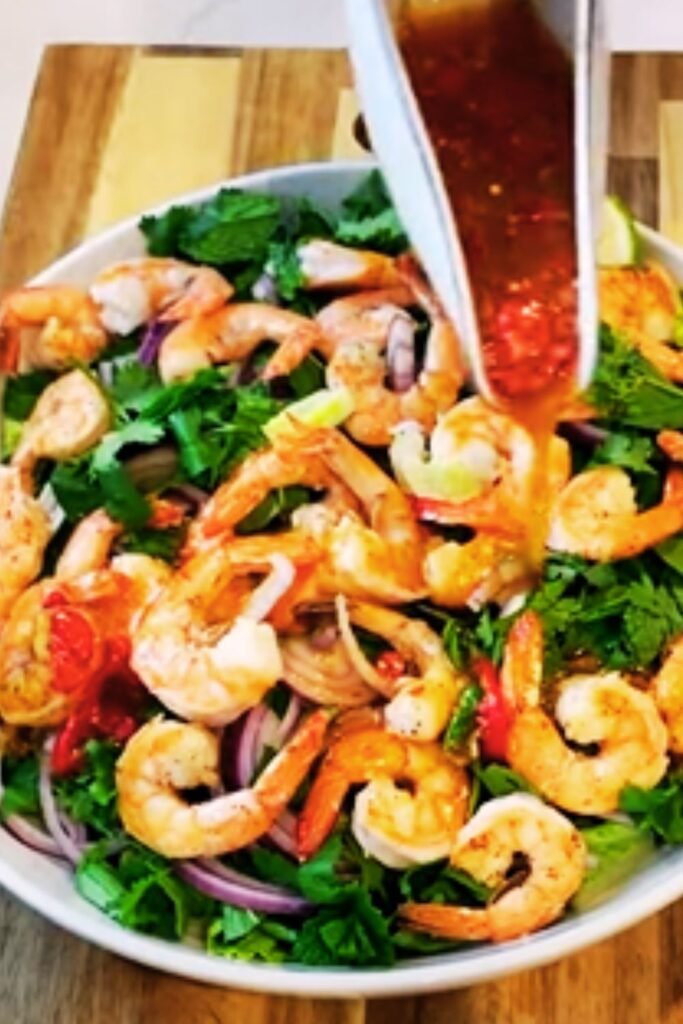
Pla Goong works beautifully as part of a larger Thai meal or as a standalone light lunch. Here are some perfect pairings:
As Part of a Thai Feast:
- Serve alongside sticky rice or jasmine rice
- Pair with Tom Yum soup for a classic Thai combination
- Balance with a milder dish like Pad Thai or Thai Basil Chicken
- Include a coconut-based curry for richness
For a Light Meal:
- Serve in lettuce cups for a refreshing hand-held option
- Accompany with fresh spring rolls
- Offer with a chilled Thai tea for the perfect cooling contrast
For a Fusion Twist:
- Serve atop mixed greens with an extra drizzle of lime dressing
- Use as a filling for rice paper rolls
- Spoon into avocado halves for a California-inspired presentation
Remember that Pla Goong is traditionally served at room temperature, not cold, which allows the flavors to shine most brightly.
Make-Ahead and Storage Tips
While Pla Goong is best enjoyed fresh, here are some tips if you need to prepare components in advance:
- Shrimp: Can be cooked up to 24 hours ahead and stored in the refrigerator. Bring to room temperature before assembling the salad.
- Dressing: Can be made up to 3 days ahead and stored in a sealed container in the refrigerator.
- Herbs and aromatics: Best prepared just before serving, but can be prepped a few hours ahead and stored in damp paper towels in the refrigerator.
- Leftovers: Can be refrigerated for up to 24 hours, though the herbs will wilt slightly. Not recommended for freezing.
- Roasted rice powder: Can be made in larger batches and stored in an airtight container for up to a month.
Questions & Answers
Q: Can I use frozen shrimp for this recipe? Yes, frozen shrimp work perfectly fine! Just ensure they’re completely thawed before cooking, and pat them dry to remove excess moisture. In fact, unless you live near the coast, frozen shrimp are often fresher than “fresh” shrimp at the seafood counter (which are typically frozen and then thawed for display).
Q: I can’t find kaffir lime leaves. What can I substitute? While kaffir lime leaves have a unique flavor, you can substitute with 1 tablespoon of lime zest combined with a bay leaf. It won’t be exactly the same, but it will provide similar aromatic notes.
Q: How can I adjust the spice level? The heat in this dish comes primarily from the fresh Thai chilies and chili powder. To reduce spice, remove the seeds from the fresh chilies or reduce their quantity. For a milder version, you can substitute serrano or jalapeño peppers. If you love heat, keep all the seeds and even add a bit more chili powder.
Q: Is fish sauce necessary? I’m concerned about the smell. Fish sauce is integral to authentic Thai flavor. When mixed with other ingredients, its strong aroma transforms into a savory depth that can’t be replicated. However, if you must substitute, use soy sauce mixed with a bit of lime juice, though the flavor profile will be noticeably different.
Q: Can I make this dish vegetarian? Absolutely! You can substitute the shrimp with firm tofu (pan-fried until golden) or royal trumpet mushrooms (sliced and briefly sautéed). Replace the fish sauce with soy sauce or a vegetarian “fish sauce” made from seaweed, available at some Asian markets.
Q: My local store doesn’t carry palm sugar. What can I use instead? Brown sugar or coconut sugar make good substitutes, though palm sugar has a more complex caramel flavor. If using substitutes, start with a bit less than the recipe calls for and adjust to taste.
The Cultural Significance of Pla Goong
In Thailand, food is never just about sustenance—it’s a celebration of flavors, community, and cultural identity. Pla Goong exemplifies the Thai approach to balancing contrasting elements to create harmony. The dish is commonly served at family gatherings and celebrations, reflecting the Thai value of food as a means of bringing people together.
What I love most about Pla Goong is how it represents the Thai philosophy of food as medicine. The fresh herbs and spices aren’t just for flavor—they’re believed to have health benefits too. Lemongrass aids digestion, chilies boost metabolism, and kaffir lime is thought to be detoxifying.
When you prepare and share this dish, you’re participating in a culinary tradition that spans generations. There’s something profoundly connecting about that—knowing your hands are creating something that countless others have made before you, each adding their own personal touch to the recipe.
Final Thoughts: Why This Recipe Works
After countless attempts at recreating the magic of that roadside eatery in Bangkok, I’ve found that the key to perfect Pla Goong lies in three principles:
- Respecting the ingredients: Allowing each component to shine rather than overwhelming the dish with any single flavor.
- Embracing balance: Ensuring that spicy, sour, sweet, and salty elements are in perfect harmony.
- Practicing patience: Taking the time to prepare each ingredient properly and allowing the flavors to meld before serving.
This Pla Goong recipe isn’t just a list of ingredients and steps—it’s an invitation to experience Thailand’s vibrant culinary tradition in your own kitchen. I hope it brings you as much joy as it has brought me.
Time to gather your ingredients and embark on this flavorful journey. Your taste buds will thank you!
Q&A Section
Q: How spicy is authentic Pla Goong? Traditionally, Pla Goong is quite spicy by Western standards. In Thailand, it would typically include 8-10 bird’s eye chilies for a similar quantity of shrimp. However, heat levels vary by region and personal preference, even within Thailand. My recipe suggests 5-8 chilies, which provides a manageable but authentic level of heat. Always adjust according to your personal spice tolerance.
Q: Can I make Pla Goong ahead for a dinner party? While you can prepare all the components ahead of time, I recommend final assembly no more than 30 minutes before serving. You can cook the shrimp, prepare the herbs and aromatics, and mix the dressing up to a day ahead (storing everything separately in the refrigerator). Then quickly assemble just before your guests arrive. The dish is traditionally served at room temperature, so it’s perfectly fine sitting out during your gathering.
Q: What’s the purpose of the roasted rice powder? Roasted rice powder (khao khua) serves multiple purposes: it adds a subtle nutty flavor, provides textural contrast, and helps absorb some of the dressing so it clings better to the shrimp. While you could technically skip it, it really elevates the dish from good to exceptional. It’s worth the extra few minutes to make it fresh, though you can prepare larger batches to keep on hand for future use.
Q: How can I tell when the shrimp are perfectly cooked? Perfectly cooked shrimp should form a “C” shape – if they’ve curled into a tight “O” shape, they’re overcooked. They should be opaque throughout with a pink/orange hue on the outside. This typically takes just 2-3 minutes in boiling water. Remember that carryover cooking will continue even after you remove them from the heat, which is why the ice bath is so important to stop the cooking process immediately.
Q: What’s the best way to eat Pla Goong? In Thailand, Pla Goong is typically eaten with a fork and spoon (not chopsticks, as some might assume). The fork is used to push food onto the spoon, and the spoon is used for eating. It’s commonly enjoyed with sticky rice, which is rolled into small balls with the fingers and used to scoop up the salad and its flavorful dressing. For a more casual approach, serving it with lettuce cups allows guests to create their own wraps.

